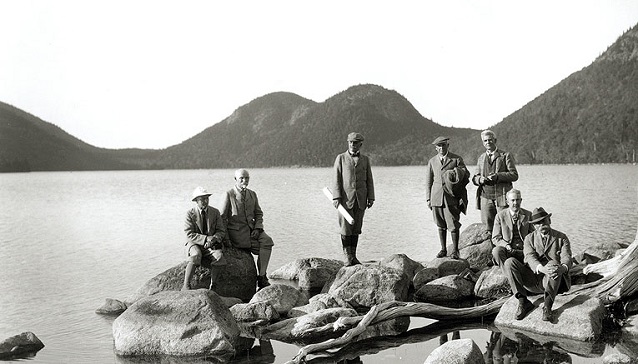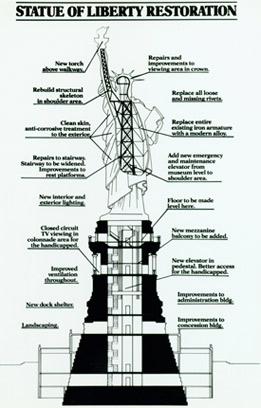The earliest donation

NPS Archives
Private philanthropy has played a major role in advancing the national parks and the National Park Service. In the years before Congress routinely appropriated funds for park lands, and later when land acquisition needs exceeded and continue to exceed appropriations, private donations were and are responsible for substantial additions to the national park system. Other donations have contributed significantly to park planning, development, management, and interpretation.
The park system benefited from private contributions even before Congress created the National Park Service on August 25, 1916. In 1907 Mr. and Mrs. William Kent donated what became Muir Woods National Monument, California; and in June 1916 a group formed by George B. Dorr, Charles W. Eliot, and others gave the land for Sieur de Monts National Monument in Maine, the forerunner of Acadia National Park. These were the first of many parks created or enlarged by philanthropy.
Before and after he became the first director of the National Park Service in 1917, Stephen T. Mather contributed much from his personal fortune to support the parks and their administration. In 1915 he and others bought the privately owned Tioga Road for Yosemite National Park for $15,500. The next year he got several western railroads to join him in contributing $48,000 to publish the National Parks Portfolio, which publicized the parks and helped persuade Congress to create the National Park Service. Among his later personal expenditures, Mather provided $25,000 in 1920 to build the Rangers Club at Yosemite.
Park museums
The first park museums resulted largely from philanthropy. A museum at Mesa Verde National Park built with contributions from Stella Leviston of San Francisco and John D. Rockefeller, Jr., opened in 1925, as did a museum at Yosemite funded by the Laura Spelman Rockefeller Memorial. In 1926 the Rockefeller Memorial underwrote the cost of the Yavapai Observation Station Museum at Grand Canyon National Park, and in 1928 it contributed $118,000 for four focal-point museums in Yellowstone National Park. Mr. and Mrs. B. F. Loomis gave the Loomis Memorial Museum and forty acres of land to Lassen Volcanic National Park in 1929. Congress made no significant appropriations for park museums until it funded construction of the Sinnot Memorial Observation Station Museum at Crater Lake National Park in 1930; even then the Carnegie Foundation paid for the museum's exhibits and equipment.
Family giving

The contributions of John D. Rockefeller, Jr., and his son Laurance S. Rockefeller to expand the national park system are especially remarkable. They gave more than $3 million for land and park roads at Acadia, more than $2 million to enlarge and improve Grand Teton National Park, more than $5 million for land to establish Great Smoky Mountains National Park, more than $2 million for the land comprising Virgin Islands National Park, more than $1.6 million to expand Yosemite, and lesser amounts for lands at Big Bend, Glacier, Grand Canyon, Haleakala, Lassen Volcanic, Olympic, Rocky Mountain, and Shenandoah national parks; Antietam, Big Hole, and Fort Donelson national battlefields; Capulin Volcano and George Washington Birthplace national monuments; Colonial National Historical Park; Ford's Theatre National Historic Site; and the Blue Ridge Parkway. In 1993 Laurance and his wife, Mary, gave their historic Vermont estate valued at $21.4 million with a $7.5 million endowment to establish Marsh-Billings National Historical Park.
The Rockefellers continued to make major contributions to other National Park Service activities as well. In 1986, for example, Laurance and his Jackson Hole Preserve, Inc., helped launch the Horace M. Albright-Conrad L. Wirth Employee Development Fund, which makes grants to park service employees enabling them to further their personal and professional growth. And in 1991 they helped finance the service's 75th anniversary symposium at Vail, Colorado, which produced "The Vail Agenda" for national parks in the 21st century.
After the Rockefellers, the Mellon family has contributed most generously to the growth of the park system. Between 1947 and 1971, family foundations gave nearly $7 million to fund seacoast and Great Lakes shoreline surveys leading to the creation of several national seashores and lakeshores, to purchase much of the land for Cape Hatteras and Cumberland Island national seashores, and to enable federal acquisition of Hampton National Historic Site. Other Mellon gifts contributed to the preservation of Redwood and Rocky Mountain national parks. In 1990 the Richard King Mellon Foundation donated another $10.5 million for lands at Antietam, Fredericksburg, Gettysburg, and Petersburg battlefields; Pecos National Historical Park; and Shenandoah National Park. Mellon foundations have also given generously to other National Park Service activities, from the landscaping of Lafayette Park fronting the White House to the Vail symposium.
Finishing touches

Many other persons and groups have donated or funded single parks or park additions. There is room here for only a few examples illustrating the range of such gifts. On behalf of Adams family descendants, the Adams Memorial Society donated Adams National Historic Site. The Fort Frederica Association purchased additional land for Fort Frederica National Monument. Lloyd W. Smith donated Jockey Hollow, a major component of Morristown National Historical Park. The Roosevelt Memorial Association donated Theodore Roosevelt Island. Margaret Louise Van Alen, Frederick W. Vanderbilt's niece, donated Vanderbilt Mansion National Historic Site. And Catherine Filene Shouse donated the land and theater for Wolf Trap Farm Park for the Performing Arts.
Numerous park facilities and improvements beyond those already mentioned have been made possible by private philanthropy. Again, just a few examples must serve. Louise du Pont Crowninshield contributed historic furnishings for houses at George Washington Birthplace National Monument and Salem Maritime National Historic Site. Claud E. Fuller gave a major firearms collection for exhibit at Chickamauga and Chattanooga National Military Park. The American Pioneer Trails Association funded a museum wing at Scotts Bluff National Monument. In the largest park fund-raising venture to date, corporations joined with individuals, foundations, and other nonprofit entities in contributing more than $350 million to refurbish the Statue of Liberty and restore Ellis Island's Great Hall during the 1980s. Between 1988 and 1998, Mount Rushmore National Memorial supplemented revenues from concession contracts and commemorative coin sales with $11 million in personal and corporate gifts to carry out major preservation work on its colossal sculptures and renew its visitor facilities. In 1998 the Haas family donated $10 million to redevelop Crissy Field at Golden Gate National Recreation Area as a shoreline park. Also in 1998, Walter and Leonore Annenberg gave $10 million to help develop a new Liberty Bell complex and provide other improvements in the Independence Mall area of Independence National Historical Park.
Congressional recognition
Congress formally recognized the importance of private philanthropy to the parks in 1935 when it established the National Park Trust Fund Board to receive gifts for the benefit of the National Park Service and its activities. This body did not live up to expectations, and in 1967 Congress replaced it with a more productive successor, the National Park Foundation. The Secretary of the Interior and the Director of the National Park Service are ex officio, non-voting members of the Foundation’s board. Launched with a $1 million contribution from Laurance Rockefeller, the National Park Foundation has invested more than $700 million across the National Park System over the last half-century. It became increasingly active during and after the 1980s as federal budget concerns prompted more interest in obtaining private support to meet park needs. Since then, especially through the NPS Centennial celebration, the National Park Foundation has grown and dramatically increased its support for parks and NPS programs, often in partnership with other philanthropic organizations and initiatives. In 2016 alone, the Foundation granted more than $100 million to 302 national parks, programs, trails, heritage areas, and other public lands. It helped establish four new national parks and conserved more than 89,000 acres at nine parks. Through Find Your Park / Encuentra Tu Parque, 1.3 million new followers joined the national park community on social media!
Concluding thoughts
Philanthropy is more than a source of land and money for the parks. It is a means of building and strengthening bonds between the parks and their advocates. While all taxpayers contribute to the parks, those who make additional voluntary contributions will have a special interest in their welfare. The parks and the National Park Service benefit from their devotion as well as their dollars.
Last updated: July 6, 2018
